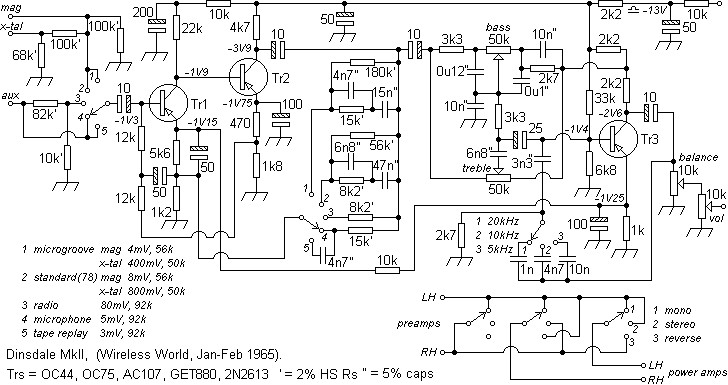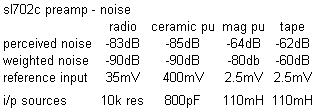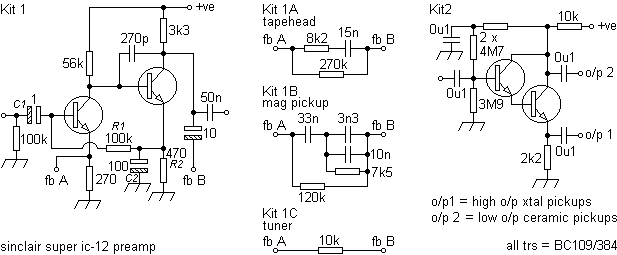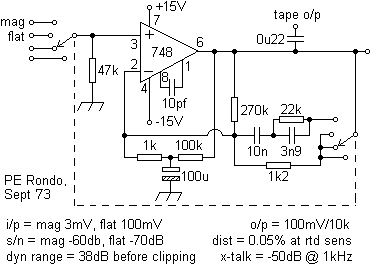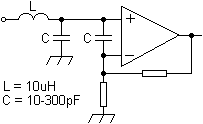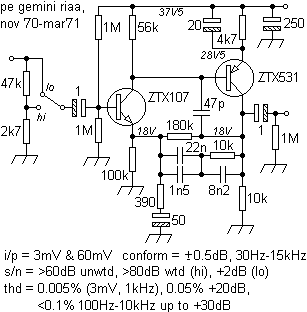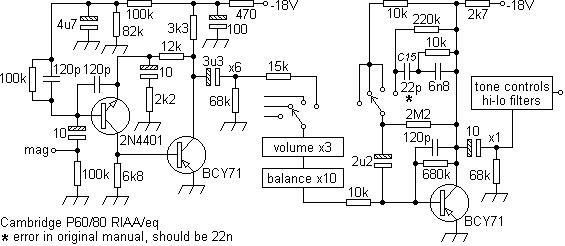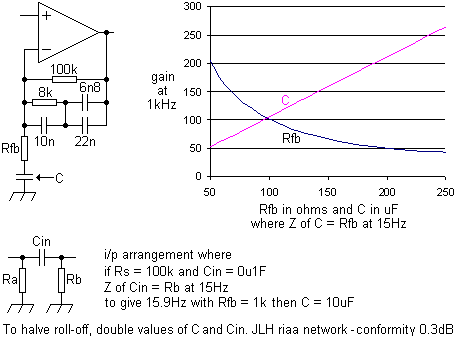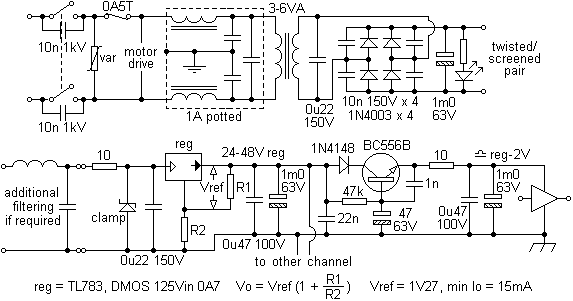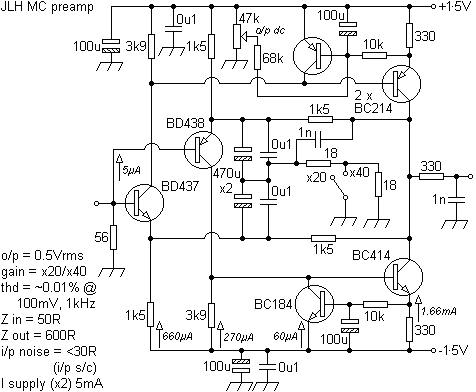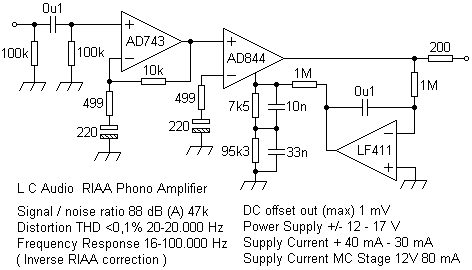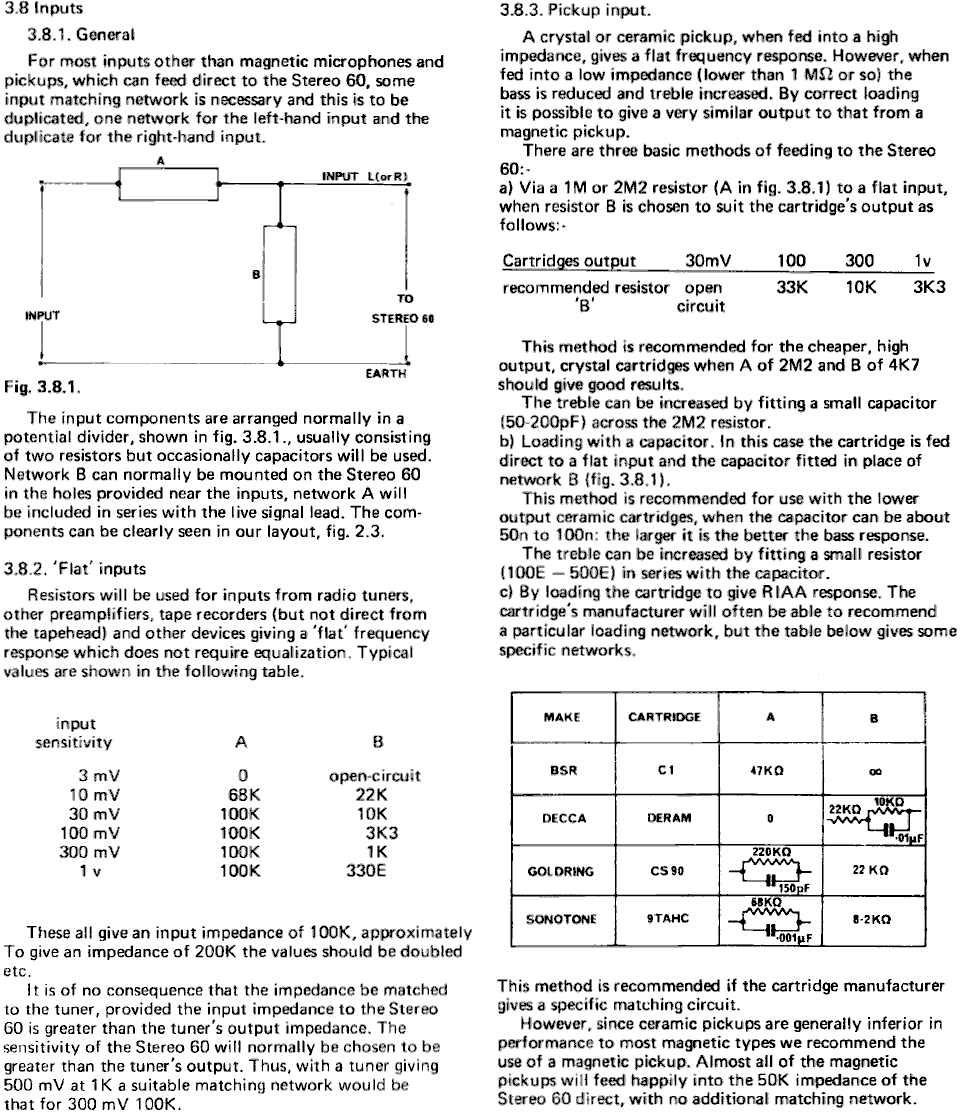Sundry styli interfaces
The invention of stereo reproduction from a single groove is often attributed to Bell Telephone Labs and Blumlein but it would appear that they were pre-empted by about a decade. Samuel S. Waters of Washington DC was granted patent No 1520378 on 23rd December 1924 (application dated 3rd July 1920) which describes a mechanico/acoustic transducer for independent operation from each groove wall. The arrangement anticipated by 30 years the couplers between stylus and crystal used in stereo crystal pickups.
To get the best interface between a stylus and a record, it is best to replay the record in exactly the same manner in which the master was cut, ie; tangentially, 15° from the normal, although some high-spec cartridges will use a far higher angle. Radial arms will obviously, because of the trajectory induced in the stylus' travel, introduce distortion that remains of intense discussion, but nevertheless satisfies the majority of tastes. To obtain carrier-channel information, or improved high frequency performance, a defined stylus edge is required, and a decent tangential deck.
Tangential arms will not only reduce radii errors by at least an order of magnitude, but will reduce stylus and record wear. A high quality record deck with a radial arm giving a stylus to pivot mass (Me) of 9gm will exert on a record of some 650 grooves (counted on the radius, a record having only two continuous grooves, one on each side) played once a week for five years some 315,900 ergs, enough to lift a 63kg man 5cm off the ground. A tangential arm offering a Me of 4gm will exert 140,400 ergs, or 56% less. Useful examples are the Beogram 6000, Revox B795 and the compact Technics SL-10. Useful DIY references are posted by Traddles.
If radial arms are used these should have a low-mass and low friction gimbal suspension. A very desirable feature is an auto-return at the end of the record and is considered essential for normal use. The Technics SL-Q2 is a good example. Arms like SMEs can be very nice to own but one can become tired by the sound of a stylus trapped in the last groove.
Some users mix 'n' match styli of one make for those of another without apparent detriment, in fact many decks giving satisfactory domestic or commercial service have been seen where the stylus fitted is neither of the same make or even compatible physical type. This does not surprise given that one 1990 catalogue offered in excess of 600 different types although most retailers could cover most needs with a range of, say, 40.
Some moving-coil/transformer combinations cost more than most would pay for an entire system. The same could be said about arms, the Odyssey Engineering RP1 tone-arm, for example, being available in any finish desired by the customer, including gold. Another type floated on silicone, while another (tangential) offering traversed the record on a pair of precision quartz rods. A Revox solution used magnetic suspension, whilst a topline Sony arm had sixteen motors in it. Putting this on an onyx plinth with a self-centring turntable before blowing a fortune on the best cartridge money can buy might impress some, but one still had to get up to change the record! One can then spend on a preamp what other's will pay for a car, eg; Audio Research SP-11, Yamaha C-1, etc. Unfortunately, many of those seeking 'the best' simply spend money in order to express taste or flaunt resource, with no real benefit. Despite the use of teak, steel, aluminium, magnesium and carbon fibre, the author has yet to meet the individual who can differentiate, by hearing alone, between a choice of top-line tone arms, disregarding wiring issues. More recently, a deck intended for domestic use was priced at £18k with matching cartridge for £5k. If the author ever seriously considered spending £5k on a cartridge, he would not be mounting it on a radial arm.
Some users claim that a direct connection between a cartridge output and the preamp's input transistor is best, some that a transformer's lack of 'presence' is objectional, others that AC coupling is acceptable provided the inadequacies of electrolytics are understood. Simply being sensible will achieve the best results and at the lowest cost.
Notwithstanding the mechanical noise generated by a record deck, care must be taken to reduce the electrical noise appearing on a vulnerable input. For example, an earthed coat of silver/nickel-loaded paint on a plastic cartridge body has reduced susceptibilty to flourescents. Headshell connections must be clean and sound, with preferably screened cables in an earthed arm although some will use litz wire. Detachable ones with two locking pins are recommended since a surprising number of decks use headshells which can be loose even when correctly locked, dust, dirt and intermittent connections being a common source of noise. Care should always be taken to either turn the volume on the amplifier down or switch it off before removing a headshell because the resulting noise can damage speakers.
It then makes sense to position the stages where most amplification (and/or equalisation) takes place as near to the source as possible, eg; a record-deck fitted with a RIAA preamp. In an electrically noisy environment, a higher output will sustain a comparably lower noise floor than a much smaller signal. The number of switches, cables and connectors that can degrade the signal is also reduced, many excellent integrated hi-fi preamp designs suffering as a consequence of having four or more friction contacts in the signal and feedback paths, apart from those between the cartridge and input socket. If this is unavoidable, use gold-on-gold contacts only, even though when new these can give a thermal EMF of 1-40µV each. Personal preference attempts to avoid mechanical switch contacts in any RIAA circuit.
By necessity, given the low frequency gain of this stage (>55dB @ 50Hz, say), power supplies must be regulated and decent screening be employed, the object being to reduce supply ripple to 2mV, or much less, and hum signals on the input to <1µV (giving with a 1mV output a signal to noise ratio of -60dB). Mount the preamp as close to the arm as possible and the mains filter, transformer, bridge rec and smoother in the opposing corner, keeping mains and signal wiring as far apart and as short as possible. Return all earths to a single point, ideally at the preamp input, (spider or star) to prevent circulating currents and preferably use steel for screening. If the preamp ground is intended to be isolated, or 'lifted', experience suggests that an HF path via a 10n ceramic disc capacitor to adjacent metalwork is a good idea. The deck can then feed a power amp directly, if desired (via a volume control). When undertaking a 'mod' it can be helpful if it is understood that although a 600R phono line might suffice for most needs, an additional balanced one will cope with long runs.
Some cartridge manufacturers specify a capacitive loading, usually of about 200pF, to simulate or account for a connecting cable. Some, like the Shure V15 Mk3, can require as much as 4-500pF. Ideally then, the frequency response would be flat from 30Hz to 8kHz. Beyond these limits the curve can deviate to ±3dB at 20kHz, with a ripple.
The connecting media can easily influence the cartridge's sonic qualities, much like a guitar's pickup. Residual capacitance in a high quality arm, like the SME series 4/5, would amount to some 15pF (internal) and 140pF between cable conductors. Adding capacitance across a preamp input can reduce high frequency performance, result in peaking and even oscillation (an 'average' 4-5' connecting lead offering some 100pF per foot can resonate at about 10kHz with a 500mH load), but appears mostly to be a matter of taste, the average listener using an average to good system being unaware of any changes. At the same time, some padding boxes can introduce noise due to the switching elements involved, some efforts being truly shoddy examples of workmanship.
This area can be investigated, but requires the use of reference frequency response recordings and relevant test gear in order to dispense with subjective influences since psychological and physiological factors will often be the major determining forces in perception, peaking at high frequencies sometimes appearing to offer greater detail. High frequency fall-off can occur at reduced temperatures due to stiffening of a cantilever's butyl rubber suspension, especially with miniature designs, although some manufacturers will have taken some trouble to overcome this, like the Technics proprietary TTDD temperature defence damper, for example. For this reason, CD4 decoder dropout can occur in low ambient temperatures because of the cartridge's upper response being reduced.
Manufacturers estimate dynamic ranges of the order of 50-60dB and a 70dB signal to noise ratio with a first-rate LP pressing. A preamp S/N rating higher than this, with a high overdrive margin to accommodate differing depths of groove modulation and cartridge outputs will, in effect, be transparent, given that cartridge reference outputs can vary by some 14dB. Those intended for carrier-channel use (CD4, etc) can be expected to give an output 6dB lower than 'ordinary' hi-fi cartridges, the same can be said of those designed with lighter tracking forces in mind (low effective tip mass), bearing in mind that at 33rpm the wavelength at 1kHz can be 0.0018" at the outer edge of a record and 0.00075" at the inner (such dimensions emphasising the importance that dust will have).

Moving coils reduced outputs even further and, because of the reduced inductance, could extend the frequency response well into the ultrasonic range then giving rise to distortion in later amplifier stages. Channel separation can be 20dB (at 1kHz, less at higher frequencies) with a low-end cartridge and maybe up to 32dB with a better one compared to the 40-45dB separation possible from a decent FM tuner's MPX decoder. Maximum playing time at 33rpm is 53 minutes.
One notices how distortion specs are usually absent from a record deck's specs given the importance with which they are considered when comparing amplifiers. Garrard, in particular, omitted these from their later turntables and probably with good reason. Some manufacturers would adopt non-standard measurements that were then not directly comparable. With radial tracking, for example, it was usual, due to the dimensions of the waveforms involved, to aim for a minimum error at the inner groove. Apart from the wow/flutter and rumble (which could sometimes be caused by acoustic feedback from the speakers) inherent in the motor train, colouration can then be dependent on the type of arm, the method of mounting this and even whether an original stylus is used. Using good-quality audio equipment of, say, early '80s vintage a record deck could produce 3-6% with 8-10% being typical and even 20% on the inner grooves, even with the best cartridges and records (e.g. 1.2% and 0.6% harmonic distortion for 20cm/s at 1kHz vertical and lateral modulation respectively for a good-quality pick-up cartridge in a good-quality arm, rather than in comparison with the less than 0.1% t.h.d. typical of a good-quality audio amplifier). The best way to demonstrate this, say to a sceptical 'audiophile', is to project both R and L signals from a favoured deck and preamp as a Lisajous figure on a 'scope with a mono record, comparing this to a mono FM broadcast.
As with distortion, noise figures can confuse, unless one is an engineer, which most music listeners are not. Differing standards involving filtering can appear to offer lower quoted specs which can appeal to marketing departments, eg;
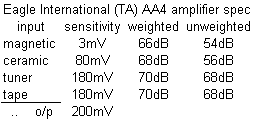

The accuracy of the reproduction of the eq curve may not necessarily be of the importance that one might think. During manufacture the recording's upper and lower ends might have been 'tweaked' say to suit the cutting engineer's speakers and listening room or to reduce excessive modulations allowing closer spacing of the grooves. What is important is the matching of both channel's curves, but there may be little point in pursuing fractional dB specs that will be beyond the audible limits of the rest of the equipment used and the capabilities of the listener. Some commercial deviations can amount to ±6dB from 50Hz to 18kHz. One of the functions of the inclusion of tone controls in an integrated amplifier was to accommodate differing recording curves like the old Columbia, AES and London types. For example, from the Leak Stereo 70 instructions ('Operating the controls when playing records') some advice that is still pertinent;
"15.(a) The 'RIAA' (same as British Standard 1928/61 for Fine Groove Records) playback characteristic has been incorporated in the 'Stereo 70' as this is an internationally agreed standard, and has been in world-wide use since 1955 for 33 and 45 rpm records. This characteristic does not take into account the acoustics of the recording studio, the position of the microphones relative to the artistes, your pickup, your loudspeaker systems, the acoustics of your room, and your particular ears! In other words, the playback characteristic is of use only as an approximation, and it may well be necessary to adjust the final result by using the controls marked 'BASS' and 'TREBLE'; this is the reason for their presence. When playing LP records (33 and 45 rpm) made prior to 1955 the bass and treble controls may be used to correct for differences in the recording characteristic. When playing European 78 records the 'TREBLE' control should, theoretically, be turned to 2 o'clock and the bass control to 11 o'clock but, here again, you may prefer the results with the controls at 12 o'clock!"
Redundant tunerheads and large RF/IF cans provide ideal enclosures for preamps. Tropicalisation, which usually consists of spraying equipment's circuitry with a lacquer (and the inclusion of a desicant in enclosures), helps to reduce corrosion from condensation that can arise, say, from warm gear being put into a cold van after a gig or use in high humidities. During construction, this can be done properly (even potting) adding service life. Although there is nothing wrong with ±5% carbon resistors, for best results use ±1% metal-film resistors and polystyrene, mica, polypropylene or polycarbonate capacitors for filtering and equalisation. For these parts of a circuit a low temperature coefficient is considered vital. The absorption of humidity can increase a capacitor's value (polystyrene in particular), sealed types do not suffer this problem.

The operating voltage dependence of a ceramic capacitor's value can cause unwanted fluctuations in the desired frequency response and should be avoided as should the microphonics evident in some types. Polyester dielectric capacitors can produce an HF overshoot, superior polystyrene and polycarbonate types do not. Tantalum types can exhibit a semiconductor effect that can introduce distortion. Bi-polar electrolytics can perform badly and unless certified to perform should be avoided, polarised types can do well but should operate with a DC bias applied.
Another's view of a capacitor's equivalence.
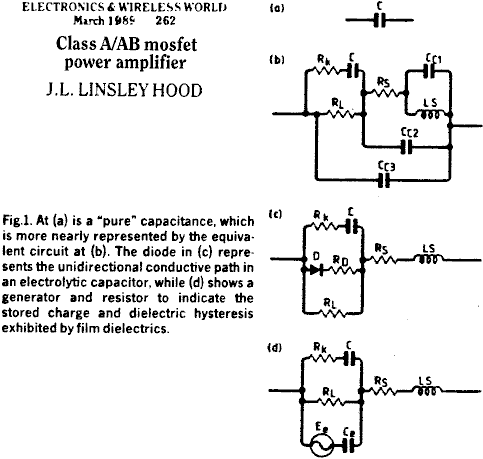
For eq networks the author favoured 1% types like the Ashcroft M37/50 (resin dipped silver mica), the smaller LCR EXFS/HR series (radial polystyrene sealed in resin case) or the Philips 460/4 series (axial polypropylene with epoxy lacquer). For RF decoupling or suppression on inputs low K, NPO/COG (BSI IB) ceramic types were used. Metal film resistors can be Philips MRS16T (0W4, 1%, 50ppm) or for a tighter match Welwyn RC55 (0W25, 0.1%, 15ppm). For audio aerospace ultra-high precision types like the Vishay RCK series (down to ±0.005%) are considered to be over-kill and unnecessary.
If an 'absolute' solution is desired parallel and series combinations can be used, eg:

In this situation it is best to determine the capacitor types, tolerances and sources first, the resistive elements being easier and cheaper to select. With this approach a larger amount of thermal energy is required to alter the characteristics of the larger bulk of the array then arguably giving greater stability over time.
Examples of representative cartridge specs given over some 40 years are set out at the bottom of the page.
Much work has been done on RIAA equalisation, those repeatedly refered to are the contributions by Baxandall and Lipshitz. Some PDFs of these have been kindly contributed and will be made available, where possible, on request. Recommended also are some JLH designs and the extensive work done by Tomlinson Holman. A detailed discussion, together with a proposed design that some may consider complex, is offered by Dimitri Danyuk and George Pilko (Kiev 1988-'90). Stan Curtis' System A (copies of scans of original article which contained some errors is available on request) used a modular approach to meet individual needs and 'discrete component operational amplifier's using selected devices. More than 65 different MM and MC preamps are shown below, detailed discussion of which is avoided to save space and not to deter new-comers to the subject. John Curl's work in this field is notable, however, some designs proposed are heavily dependent on the close matching of active elements.
The first solid-state hi-fi component, the Fisher TR-1 phono and microphone preamp (mono and battery powered, early 1956) is covered well by Bob McGarrah, a review of which can be found here. Some data is available on early transistors, Philco types and a 1953 Commercial Transistor Data Chart being examples.
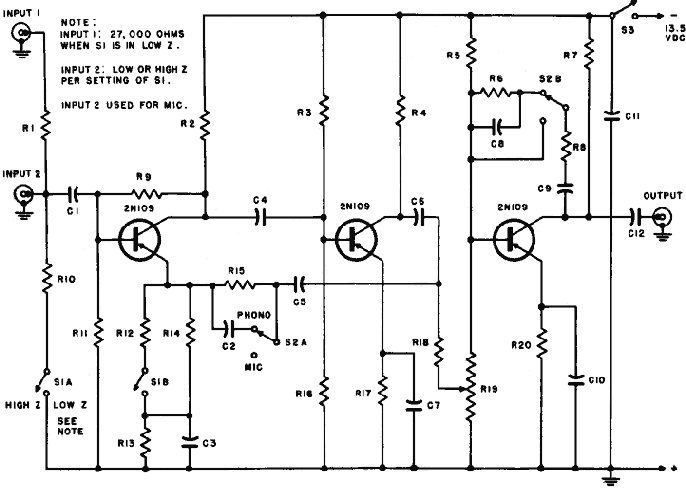
This preamp offered a frequency response of 20Hz to 20kHz within 2dB and a noise level 60dB below 2mV for low impedance cartridges. The striking features compared to valve designs were that it offered a hum level and microphonics of 'absolute zero' and a power consumption of 33mW (2½mA). Capacitor coupling between the stages helps reduce the thermal effects inherent in transistor junctions (see below).
From an educational point of view, the 1965 Dinsdale Mk II is considered important. With a preamp capable of handling the then new magnetic cartridges for microgroove as well as 78 rpm records, this design covered most problems encountered with integrated stereo designs.
